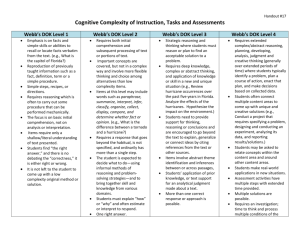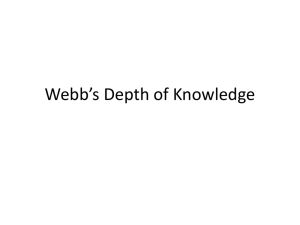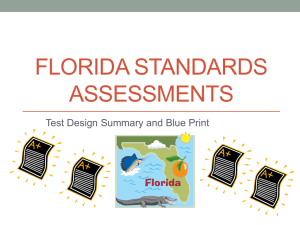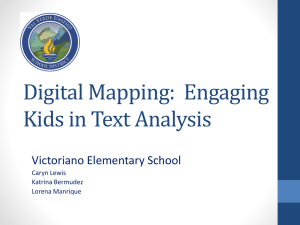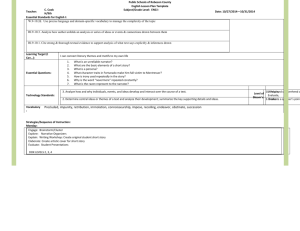Claim 2, 3, 4 Descriptions Grades K-8
advertisement
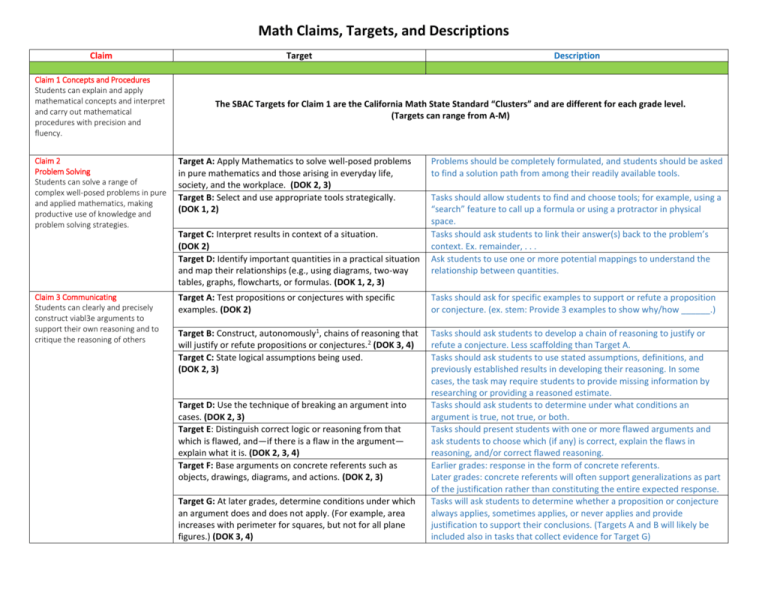
Math Claims, Targets, and Descriptions Claim Claim 1 Concepts and Procedures Students can explain and apply mathematical concepts and interpret and carry out mathematical procedures with precision and fluency. Claim 2 Problem Solving Students can solve a range of complex well-posed problems in pure and applied mathematics, making productive use of knowledge and problem solving strategies. Target The SBAC Targets for Claim 1 are the California Math State Standard “Clusters” and are different for each grade level. (Targets can range from A-M) Target A: Apply Mathematics to solve well-posed problems in pure mathematics and those arising in everyday life, society, and the workplace. (DOK 2, 3) Target B: Select and use appropriate tools strategically. (DOK 1, 2) Target C: Interpret results in context of a situation. (DOK 2) Target D: Identify important quantities in a practical situation and map their relationships (e.g., using diagrams, two-way tables, graphs, flowcharts, or formulas. (DOK 1, 2, 3) Claim 3 Communicating Students can clearly and precisely construct viabl3e arguments to support their own reasoning and to critique the reasoning of others Description Problems should be completely formulated, and students should be asked to find a solution path from among their readily available tools. Tasks should allow students to find and choose tools; for example, using a “search” feature to call up a formula or using a protractor in physical space. Tasks should ask students to link their answer(s) back to the problem’s context. Ex. remainder, . . . Ask students to use one or more potential mappings to understand the relationship between quantities. Target A: Test propositions or conjectures with specific examples. (DOK 2) Tasks should ask for specific examples to support or refute a proposition or conjecture. (ex. stem: Provide 3 examples to show why/how ______.) Target B: Construct, autonomously1, chains of reasoning that will justify or refute propositions or conjectures. 2 (DOK 3, 4) Target C: State logical assumptions being used. (DOK 2, 3) Tasks should ask students to develop a chain of reasoning to justify or refute a conjecture. Less scaffolding than Target A. Tasks should ask students to use stated assumptions, definitions, and previously established results in developing their reasoning. In some cases, the task may require students to provide missing information by researching or providing a reasoned estimate. Tasks should ask students to determine under what conditions an argument is true, not true, or both. Tasks should present students with one or more flawed arguments and ask students to choose which (if any) is correct, explain the flaws in reasoning, and/or correct flawed reasoning. Earlier grades: response in the form of concrete referents. Later grades: concrete referents will often support generalizations as part of the justification rather than constituting the entire expected response. Tasks will ask students to determine whether a proposition or conjecture always applies, sometimes applies, or never applies and provide justification to support their conclusions. (Targets A and B will likely be included also in tasks that collect evidence for Target G) Target D: Use the technique of breaking an argument into cases. (DOK 2, 3) Target E: Distinguish correct logic or reasoning from that which is flawed, and—if there is a flaw in the argument— explain what it is. (DOK 2, 3, 4) Target F: Base arguments on concrete referents such as objects, drawings, diagrams, and actions. (DOK 2, 3) Target G: At later grades, determine conditions under which an argument does and does not apply. (For example, area increases with perimeter for squares, but not for all plane figures.) (DOK 3, 4) Claim 4 Modeling and Data Analysis Students can analyze complex, realworld scenarios and can construct and use mathematical models to interpret and solve problems. Target A: Apply mathematics to solve problems arising in everyday life, society, and the workplace. (DOK 2, 3) Target B: Construct, autonomously, chains of reasoning to justify mathematical models used, interpretations made, and solutions proposed for a complex problem. 3 (DOK 2, 3, 4). Target C: State logical assumptions being used. (DOK 1, 2) Target D: Interpret results in the context of a situation. (DOK 2, 3) Target E: Analyze the adequacy of and make improvements to an existing model or develop a mathematical model of a real phenomenon. (DOK 3, 4) Target F: Identify important quantities in a practical situation and map their relationships (e.g., using diagrams, two-way tables, graphs, flowcharts, or formulas). (DOK 1, 2, 3) Target G: Identify, analyze and synthesize relevant external resources to pose or solve problems.(DOK 3, 4) Problems should not be completely formulated (as they are for Claim 2), and require students to extract relevant information through research or the use of reasoned estimates. Tasks include CR9 (“counting trees”) from the assessment sampler, and “design a tent”. Tasks ask students to use stated assumptions, definitions, and previously established results in developing their reasoning. In some cases, the task may require students to provide missing information by researching or providing a reasoned estimate. Tasks should ask students to link their answer(s) back to the problem’s context. (refer to Claim#2 Target C) Tasks ask students to investigate the efficacy of existing models and suggest improvements using their own or provided data. Other tasks will ask students to develop a model for a particular phenomenon. Longer constructed response items and extended performance tasks should be used to assess this target. This target will be embedded in a larger context for items/tasks in Claim #4. The mapping of relationships should be part of the problem posing and solving related to Claim #4 Targets A, B, E, and G. Especially in extended performance tasks (those requiring 1-2 class periods to complete), students should have access to external resources to support their work in posing and solving problems. Constructed response items should incorporate “hyperlinked” information to provide additional detail (both relevant and extraneous). *denotes additional and supporting clusters 1 by “autonomous” we mean that the student responds to a single prompt, without further guidance within the task. 2 at the secondary level, these chains may take a successful student 10 minutes to construct and explain. Times will be somewhat shorter for younger students, but still giving them time to think and explain. For a minority of these tasks, subtasks may be constructed to facilitate entry and assess student progress towards expertise. Even for such “apprentice tasks” part of the task will involve a chain of autonomous reasoning that takes at least 5 minutes. 3 At the secondary level, these chains should typically take a successful student 10 minutes to complete. Times will be somewhat shorter for younger students, but still giving them time to think and explain. For a minority of these tasks, subtasks may be constructed to facilitate entry and assess student progress towards expertise. Even for such “apprentice tasks” part of the task will involve a chain of autonomous reasoning that takes at least 5 minutes.

